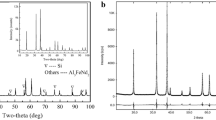Abstract
The present Time Differential Perturbed γ-γ Angular Correlation (TDPAC) measurements in bulk HfO2 report, for the first time, the presence of three regular sites at ambient condition, apart from the stable monoclinic phase (m-HfO2). Also, the effects of Gd impurity (5 at%) on HfO2 crystal structure was investigated by PAC. In pure HfO2, apart from the monoclinic component (~76%), four other minor frequency components have been found at room temperature. To further investigate the origin of these minor frequency components, PAC measurement at 673 K was performed. At 673 K, population of two of the four minor components was enhanced at the expense of the m-HfO2 as the population of m-HfO2 reduces to ~58%. On doping with 5 at% Gd, the population of monoclinic site drastically reduced to ~10% while one of the minor components got enhanced to a large extent (68%). The enhancements of the three minor components, both by temperature or by Gd impurity, indicate that these are the regular phases of HfO2 and could therefore be attributed to three orthorhombic phases of HfO2. The fourth minor component (5–10%) with values of ωQ ~ 7 Mrad/s, η = 0 can be assigned to crystalline defect site.
Similar content being viewed by others
Change history
05 September 2019
Due to technical constraints this article was published in volume 240:1 with erroneous article citation ID number 8 whereas this should have been 78 which is corrected as such. Springer Nature sincerely apologizes towards the author(s) for the inconvenience caused.
References
Wilk, G.D.: High-κ gate dielectrics: current status and materials properties considerations. J. Appl. Phys. 89, 5243–5275 (2001)
Wilk, G.D., Wallace, R.M., Anthony, J.M.: Hafnium and zirconium silicates for advanced gate dielectrics. J. Appl. Phys. 87, 484–492 (2000)
Nguyen, N.V., Albert, D., Chandler-Horowitz, D.: Sub-bandgap defect states in polycrystalline hafnium oxide and their suppression by admixture of silicon. Appl. Phys. Lett. 87, 192903 (2005)
Venkatesan, M., Fitzgerald, C.B., Coey, J.M.D.: Unexpected magnetism in a dielectric oxide. Nature. 430, 630 (2004)
Mueller, S., Adelmann, C., Singh, A., Van Elshocht, S.: SchroederU., Mikolajick,T.:ferroelectricity in Gd-doped HfO2 thin Films.ECS J. solid state. Sci. Technol. 1(6), N123–N126 (2012)
Sang, X., Grimley, E.D., Schenk, T., Schroeder, U., LeBeau, J.M.: On the structural origins of ferroelectricity in HfO2 thin films. Appl. Phys. Lett. 106, 162905 (2015)
Fancher, C.M., Zhao, L., Nelson, M., Bai, L., Shen, G., Jones, J.L.: Pressure-induced structures of Si-doped HfO2. J. Appl. Phys. 117, 234102 (2015)
Ohtaka, O., Yamanaka, T., Kume, S., Hara, N., Asano, H., Izumi, F.: Structural analysis of orthorhombic hafnia by neutron powder diffraction. J. Am. Ceram. Soc. 78(1), 233–237 (1995)
Huan, T.D., Sharma, V., Rossetti Jr., G.A., Ramprasad, R.: Pathways towards ferroelectricity in hafnia. Phys. Rev. B. 90, 064111 (2014)
Ayala, A., Alonso, R., López-García, A.: Temperature dependence of the hyperfine electric-field-gradient tensor at 181Ta in HfO2. Phys. Rev. B. 50, 3547–3552 (1994)
Taylor, M.A., Alonso, R.E., Errico, L.A., López-García, A., de la Presa, P., Svane, A., Christensen, N.E.: Coexistence of different charge states in ta-doped monoclinic HfO2: theoretical and experimental approaches. Phys. Rev. B. 82, 165203 (2010)
Catchen, G.L.: Perturbed-angular-correlation spectroscopy: renaissance of a nuclear technique. MRS Bull. 20(7), 37–46 (1995)
Schatz, G., Weidinger, A.: Nuclear Condensed Matter Physics; Nuclear Methods and Application. translated by J. A. Gardner. John Wiley, New York (1996)
Dey, C.C.: A perturbed angular correlation spectrometer for material science studies. Pramana. 70(5), 835–846 (2008)
Banerjee, D., Gupta, S.K., Patra, N., Raja, S.W., Pathak, N., Bhattacharyya, D., Pujari, P.K., Thakare, S.V., Jha, S.N.: Unraveling doping induced anatase–rutile phase transition in TiO2 using electron, X-ray and gamma-ray as spectroscopic probes. Phys. Chem. Chem. Phys. 20, 28699–28711 (2018)
Banerjee, D., Das, P., Guin, R., Das, S.K.: Nuclear quadrupole interaction at 181Ta in hafnium dioxide fiber: time differential perturbed angular correlation measurements and ab initio calculations. J. Phys. and Chem. of Solids. 73(9), 1090–1094 (2012)
Forker, M., de la Presa, P., Hoffbauer, W., Schlabach, S., Bruns, M., Szabó, D.V.: Structure, phase transformations, and defects of HfO2 and ZrO2 nanoparticles studied by 181Ta and 111Cd perturbed angular correlations, 1H magic-angle spinning NMR, XPS, and x-ray and electron diffraction. Phys. Rev. B. 77, 054108 (2008)
Hoffmann, M., Schroeder, U., Schenk, T., Shimizu, T., Funakubo, H., Sakata, O., Pohl, D., Drescher, M., Adelmann, C., Materlik, R., Kersch, A., Mikolajick, T.: Stabilizing the ferroelectric phase in doped hafnium oxide. J. Appl. Phys. 118, 072006 (2015)
Lee, Choong-Ki, Cho, E., Lee, H., Hwang, C., S., Han, S.: First-principles study on doping and phase stability of HfO2. Phys. Rev. B 78, 012102 (2008)
Wang, L.G., Xiong, Y., Xiao, W., Cheng, L., Du, J., Tu, H., van de Walle, A.: Computational investigation of the phase stability and the electronic properties for Gd-doped HfO. Appl. Phys. Lett. 104, 201903 (2014)
Batra, R., Huan, T.D., Rossetti Jr., G.A., Ramprasad, R.: Dopants promoting ferroelectricity in hafnia: insights from a comprehensive chemical space exploration. Chem. Mater. 29(21), 9102–9109 (2017)
Acknowledgements
Authors sincerely thank all the members at DHRUVA reactor, BARC, Mumbai, India for successfully producing the probe nuclei at desired activity level.
Author information
Authors and Affiliations
Corresponding author
Additional information
Publisher’s note
Springer Nature remains neutral with regard to jurisdictional claims in published maps and institutional affiliations.
This article is part of the Topical Collection on Proceedings of the International Conference on Hyperfine Interactions and their Applications (HYPERFINE 2019), Goa, India, 10-15 February 2019
Edited by S. N. Mishra, P. L. Paulose and R. Palit
Rights and permissions
About this article
Cite this article
Banerjee, D., Dey, C.C., Raja, S.W. et al. Stability of monoclinic phase in pure and Gd-doped HfO2: a hyperfine interaction study. Hyperfine Interact 240, 78 (2019). https://doi.org/10.1007/s10751-019-1614-7
Published:
DOI: https://doi.org/10.1007/s10751-019-1614-7




